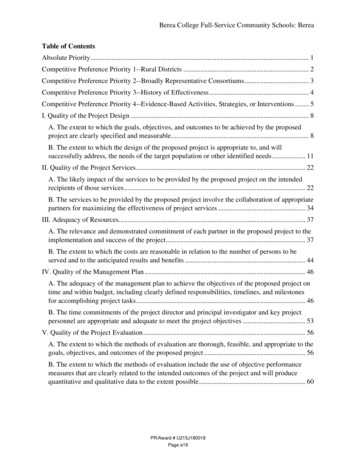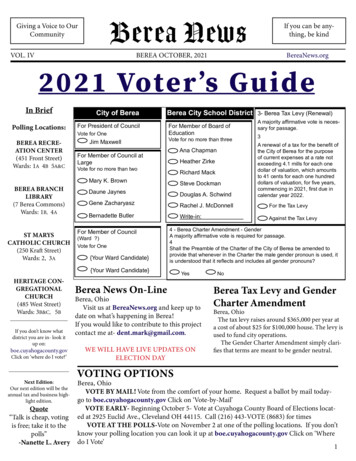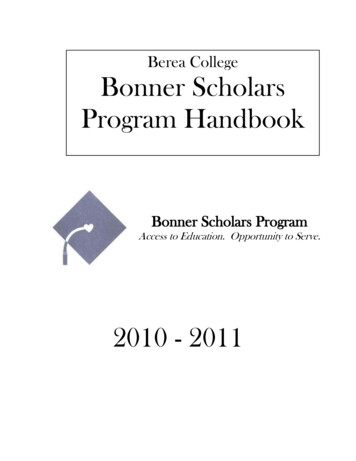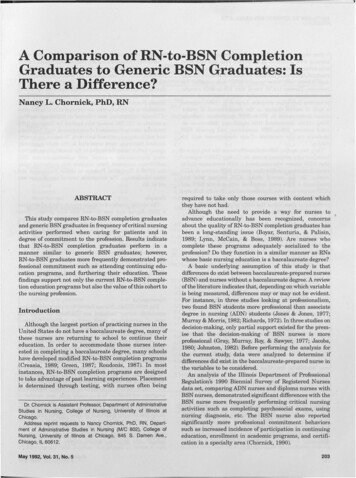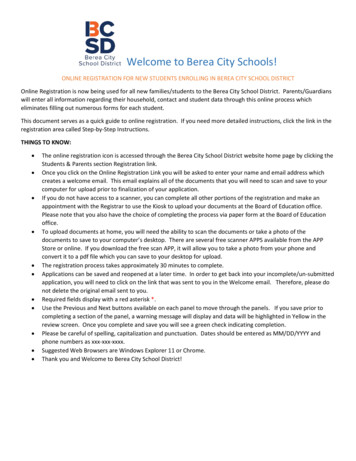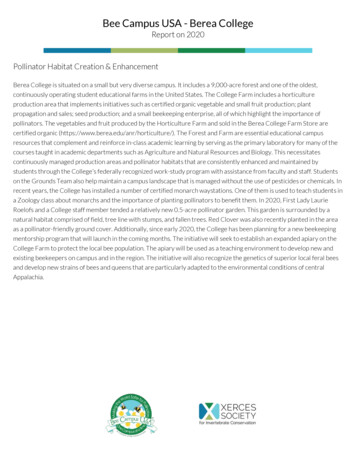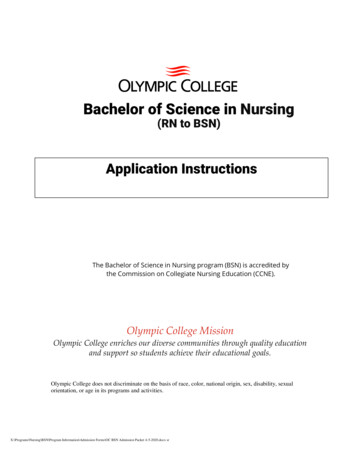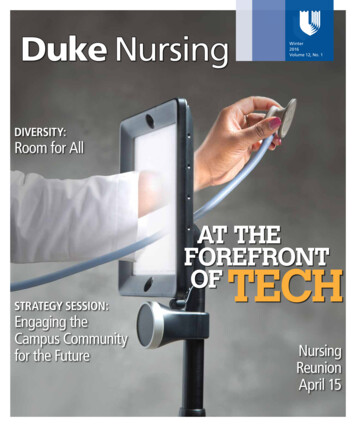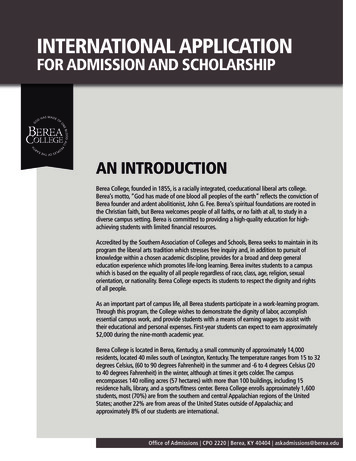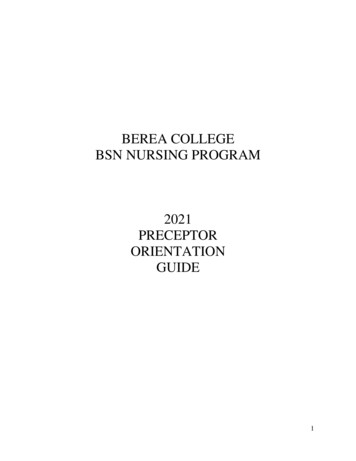
Transcription
BEREA COLLEGEBSN NURSING PROGRAM2021PRECEPTORORIENTATIONGUIDE1
Table of ContentsGUIDELINES FOR PRECEPTORS . 3PRECEPTOR VERIFICATION FORM . 6CLINICAL PERFORMANCE GUIDELINES . 7STUDENT ASSIGNMENTS R/T WITH CLINICAL . 9Clinical Hours Log . 9Midterm & Final Clinical Evaluation . 9Clinical Agency/Preceptor Evaluation Form . 9Clinical Paperwork Assignments . 10Evidence Based Practice Recommendations for Care of Complex Patient . 10Appendix A . 11NUR 450 Clinical Hours* Log Spring 2021. 11Appendix B . 12NUR 450 Clinical Evaluation Tool. 12Appendix C . 20Clinical Agency/Preceptor Evaluation Form . 20Appendix D . 22Clinical Paperwork. 22Appendix E . 25Evidence Based Practice Recommendations for Complex Patient Grading Rubric . 25NOTE: NUR 450 syllabus attached sepereately.2
GUIDELINES FOR PRECEPTORSLegal Requirement for Practicum201 KAR 20:320. Standards for curriculum of prelicensure nursing programs.RELATES TO: KRS 314.011(5), 314.021, 314.041(1)(a), 314.111(1), 314.131(1), (2)STATUTORY AUTHORITY: KRS 314.041(1)(a), 314.051(1)(a), 314.111(1), 314.131(1), (2)NECESSITY, FUNCTION, AND CONFORMITY: KRS 314.041(1)(a) and 314.051(1)(a) require that an applicantfor licensure as a registered or licensed practical nurse complete the basic nursing curriculum in an approved schoolof nursing. KRS 314.111(1) requires that schools of nursing regardless of delivery models shall meet minimumstandards and be approved by the Board of Nursing. KRS 314.131(1) and (2) authorizes the board to promulgateadministrative regulations necessary to approve programs of nursing. This administrative regulation establishes thecurriculum requirements for prelicensure registered nurse and practical nursing programs.Section 2 of 201 KAR 20:320 states the following:(9) Integrated practicum.(a) The curriculum shall include an integrated practicum. Theintegrated practicum shall consist of a minimum of 120 clockhours of concentrated clinical experience of direct patient care in ahealth care facility or health care organization.(b) The integrated practicum shall be completed within a periodnot to exceed seven (7) consecutive weeks while the governinginstitution is in session during the last semester or quarter of anursing program.Note: During the time of the Governor declared COVID-19 Emergency hospitals haveadditional requirements and restrictions for students that are expected to be followed.Students are disallowed from caring for COVID-19 positive or symptomatic COVID-19patients awaiting test results.PhilosophyThe Berea College BSN Nursing faculty believe that the use of other nursing and healthcare providers to assist students with clinical practice experiences constitutes a pedagogicallysound teaching methodology when accountability for appropriate management is exercised bynursing program faculty. This management consists of appropriate control, direction, delegation,supervision, and evaluation. The use of preceptors enhances the clinical component of thenursing curriculum by providing a blend of role modeling and mentoring with practicing nurseswho have a current clinical perspective. The precepted experience also affords the student withthe opportunity to learn autonomous and accountable nursing behavior.3
ManagementA collaborative effort between the faculty, preceptor, and student exists; however, theultimate responsibility and accountability for nursing education rests with the faculty. Thefaculty member is responsible for the application, integration, and enhancement of the theoreticalconstructs of the curriculum as related to student clinical experience. The preceptor isresponsible for acquainting the student with the clinical setting and helps provide and superviseappropriate learning experiences consistent with the student's learning outcomes. The preceptorrole encompasses the combination of the roles of mentor, supervisor, and evaluator. In additionto the concept of being a teacher, the preceptor should have: the skills of the mentor in guiding,assisting, and facilitating the student; the skills of the supervisor to ensure that relevantexperience is provided to enable learning outcomes to be achieved and to facilitate the studentscompetence in the practice of nursing; and the skills of evaluator who can assess the student'slevel of attainment in relation to the stated learning outcomes. The student is responsible foridentifying and achieving the learning outcomes and for facilitating communication betweenthemselves, the preceptor, and the faculty member. Precepted experiences must meet all thefollowing requirements regarding preceptors, faculty, Berea College’s BSN Nursing Program,and students:Preceptor Requirements1. Must have a current unrestricted nursing license as a registered nurse in theCommonwealth of Kentucky.2. Will fill out a preceptor verification form (attached) to provide information for thenursing program.3. Shall be knowledgeable and experienced in the nursing practice in which he/she isprecepting.4. Shall be approved jointly by the faculty of the BSN Nursing Program and the nursingadministration/education department of the clinical agency.5. Shall be assigned to precept students from not more than one nursing program at a timeduring the days of the experience.6. Shall agree to serve in the preceptor role and will receive orientation materials at thebeginning of the clinical experiences.7. Shall be physically present in the unit/agency and available at all times for the studentwhen performing in a nursing capacity with clients.8. Shall participate in the evaluation of the clinical experience (A copy of the midterm andfinal evaluation forms are attached.)BSN Nursing Program Requirements1. Shall have established written signed contracts with the clinical agencies utilized.2. Shall provide liability insurance for the students.3. Compile annually the evaluations of the precepted clinical experiences in conjunctionwith the clinical agency and maintain a written record of the findings.4
Nursing Faculty Requirements1. Shall facilitate orientation for preceptors regarding their preceptor role andresponsibilities within the planned clinical experiences. The faculty member responsiblefor the course will ensure that all preceptors are provided a copy of these orientationmaterials.2. Shall be responsible for no more than 10 students for any one clinical rotation.3. Shall remain ultimately responsible for the precepted experience.4. Shall be available by telephone or appoint a designee to respond to needs or concerns ofstudents and the agency in a timely manner.5. Shall communicate on a regular basis with students and agency preceptors regardingstudent progress and needs.6. Shall assume ultimate responsibility for the student's grade.7. Shall secure agreement from all involved parties acknowledging roles andresponsibilities.8. Shall continuously facilitate learning in the clinical environment and assess for suitabilityof the site.9. Shall facilitate midterm and final clinical evaluations of the precepted experiences.Student Requirements1. Shall perform a self-assessment to identify individual learning needs and shall develop awritten list of expected learning outcomes to be approved by the faculty and provided tothe preceptor to guide learning experiences.2. Shall provide the faculty member supervising the experiences a copy of the schedule ofclinical experiences as arranged between the student and the preceptor.3. Shall submit required documentation to demonstrate successful completion of the clinicaloutcomes.4. Shall work collaboratively and cooperatively with faculty member, preceptor, and clientsin initiating and implementing nursing care.5. Shall participate in regular conferences with faculty, although the frequency may vary perthe needs of the student and the judgment of the faculty advisor in collaboration and withinput from the preceptor.6. Shall participate in evaluation of the clinical experience (a copy of the form is attached).5
PRECEPTOR VERIFICATION FORMStudent Name:Term:We are required by the Kentucky Board of Nursing (KBN) to have information about the preceptors whohelp educate new nursing students. We are also required as an educational institution educating newnurses to do license verification for all preceptors.Please complete the information below and return this form (hardcopy, scan and email, or photo and text)to the faculty member coordinating the student synthesis placements:Dr. Lisa Turner:E-mail: TurnerLi@berea.eduCell phone: 859.489-5592Office phone: 859.985-3625Thank you for taking the time to help us with our compliance with the KBN.Preceptor Full Name:Preferred Contact Telephone #:Facility and Unit:KBN License #:Have you had the opportunity to precept students in the past yes noWhat is your main area of practice?Do you hold any professional certifications in your area? yes noIf yes, please list:How long have you worked in this area?What is the highest level of nursing education completed?Diploma ADN BSN MSN other (specify)Signature:Date:6
CLINICAL PERFORMANCE GUIDELINESClinical Performance is graded as Pass/Fail.Note: During the time of the Governor declared COVID-19 Emergency hospitals have additionalrequirements and restrictions for students that are expected to be followed. Students are disallowed fromcaring for COVID-19 positive or symptomatic COVID-19 patients awaiting test results.It is understood that the successful student in this course: Is self-directed and highly motivatedTakes an active role in the learning processDisplays attitudes which reflect a spirit of cooperation, flexibility and respect for all personsDemonstrates responsibility and accountability in all professional encountersMaintains a professional attitude with all persons alwaysAll 1:1 clinical experiences for this course are preceptor supervised. The Faculty will be available by cell orland phone and will make at least weekly planned observations during the semester.A total of 210 hours of clinical experience is required for this course through direct patient care with apreceptor, on-campus activities and virtual clinical experiences. Beginning in Session B, students are expectedto complete 2-3 twelve-hour shifts per week for a total of 192 hours of direct patient care with a preceptor. It isacceptable to work any of the preceptor’s work schedule (i.e., evenings, nights, and weekends). All clinicalhours must be completed on or prior to the last day of scheduled classes. See Appendix A for the Log totrack clinical hours.The faculty will work directly with the clinical agencies to set up the preceptor assignments. Students will benotified of their clinical site, preceptor’s name, and contact information will be provided. Faculty will orientpreceptor to the course syllabi, preceptor handbook and evaluation tools. Students are disallowed fromcontacting the hospitals or the nurse managers to obtain their preceptor.Once faculty have assigned the student a preceptor; the student is expected to set up an initial meeting withhis/her preceptor. This meeting can be made prior to their first clinical day or achieved at the beginning of thefirst clinical day. This initial meeting may also include scheduling clinical days and orientation to the unit. Thestudent is disallowed from asking preceptors for non-illness related schedule requests for personal reasons.The faculty will complete evaluation conferences with both the student and the preceptor at midterm and duringthe last scheduled week of the student’s clinical experience. To pass this course, students must receive asatisfactory clinical performance evaluation, as documented on the course clinical evaluation tool (SeeAppendix B).Students are expected to complete and submit to the faculty the Clinical Agency/Preceptor Evaluation Form bythe last day of the semester (See Appendix C).Throughout this course students are required to submit on Moodle five (5) Clinical Paperwork assignmentsrelated to care of a selected patient using the guidelines and template in Appendix D.7
Students are expected to follow the clinical safety policy articulated in the Nursing Student Handbook as well asagency policies at their assigned clinical site. The preceptor has the right and responsibility to interrupt studentpractice that is deemed unsafe and may remove the student from the setting if necessary.The Nursing Department is participating in the National Council of State Boards of Nursing (NCSBN) SafeStudent Reporting study to reduce errors in clinical settings including skills laboratory and simulation areas.The Safe Student Reporting (SSR) tool is an anonymous online platform that collects data on the nature andfrequency of student errors and near misses. Should a student encounter a near miss/error in the clinical setting,he/she must report it to their preceptor and course faculty for such reporting purposes (Nursing StudentHandbook 20-21, p. 13-14).In the event of clinical errors or near misses, the student will assess the patient, document in the medical recordsappropriately and complete all the required agency forms. In precepted experiences, the student has theresponsibility of notifying the faculty immediately. It is the student’s responsibility to schedule an appointmentwith the faculty and program chair as soon as possible following the clinical experience in which the erroroccurred. If the student does not notify the faculty of the error, this will be considered an effort to conceal theerror. Any efforts to conceal a clinical error will be grounds for immediate failure of the course.Students are expected to be on time for precepted experiences. Reports of being tardy from your preceptor willresult in a clinical unsatisfactory for that day. Students are not only representing themselves as potentialemployees, but as representing this college and the nursing program. The course faculty will take thepreceptor’s word that the student was late, so it is in the student’s best interest to assess the preceptor’sexpectations and then exceed them. For instance, if the preceptor normally arrives 15 minutes early to preparefor his or her shift, the student will also want to be 15 minutes early. Being a “No call/no show” will result inimmediate course failure.Each student must email Ms. Lori McKeel (Administrative Assistant) to arrange transportation. The emailshould include specific dates, pick up and return times and location. Each student will input his/her scheduleestablished with the preceptor into Box course calendar so that faculty know when each student is in clinicaland plan site visits. Realizing that schedules are subject to change, students are expected to submit any updatesto their work schedule as they arise and notify Ms. Lori McKeel of any transportation changes. Students areexpected to carpool when possible up to two individuals per van.Students are responsible for notifying by phone their faculty and preceptor and notify via email Ms. LoriMcKeel if they are unable to attend a scheduled clinical day (e.g., significant illness, inclement weather, MotorPool closing). Any charges incurred for failure to follow these mechanisms to release the vehicle will bethe responsibility of the student.8
STUDENT ASSIGNMENTS R/T WITH CLINICALMedication Calculation Clinical Competency Pass/Fail)Medication calculation exams are administered during NUR 226, NUR 350, NUR 355, NUR 400, NUR 448 andNUR 450. Students are required to pass a 10-20 question medical math test with 90% proficiency. Students,who do not pass the medical math test on their first attempt, will be required to a new version of the exam.Students may not pass medications in the clinical setting until they have successfully achieved the 90%proficiency standard. The student has up to one week to complete required remediation and retest. Students whodo not achieve 90% after three attempts, will receive clinical failure, which results in course failure. (Fac. Org8/26/19; revised 7/27/20) Nursing Student Handbook 20-21, p. 13).Clinical Skills Competency (Pass/Fail)Clinical skills competency evaluations occur at the beginning of NUR 450. Students are required to pass arandomly selected nursing skill with 100% proficiency. Students who do not pass the skill competency checkoff on their first attempt, will be required to remediate and reattempt the skill. Students may not begin theirclinical rotation until they have successfully passed the competency evaluation with the 100% proficiencystandard. The student has up to one week to complete required remediation and demonstrate proficiency in theskill. Students who do not achieve 100% after three attempts, will receive clinical failure, which results incourse failure.Clinical Hours LogStudents are expected to track their completed clinical shift on the Clinical Hours Log. Nurse preceptor areasked to sign the log to verify each shift worked with the students. See Appendix A for Clinical Hours Log.Midterm & Final Clinical EvaluationThe Berea College Faculty member will consult with the nurse preceptor when completing the midterm andfinal clinical evaluation of the student. Preceptors are encouraged to add written evaluation in on the allocatedspace of the form. Preceptors are encouraged to notify the Berea College Faculty Member as soon as possibleof any concerns about the student’s clinical performance throughout the semester. Students are encouraged toadd a written self-evaluation in the allocated space on the form as well. See Appendix B for ClinicalEvaluation Tool.Clinical Agency/Preceptor Evaluation FormStudents are asked to complete the clinical agency/preceptor evaluation form at the end of the term to give theBerea College Nursing program feedback on their clinical experience. As requested, students and/or facultywill complete evaluation forms for the clinical agency as well. See Appendix C for Clinical Evaluation Tool.9
Clinical Paperwork AssignmentsStudents will complete five (5) clinical paperwork assignments related to care of a selected patient using theguidelines and template in Appendix D. Each assignment is worth 2% of the course grade. See Appendix D forClinical Paperwork assignment details.Evidence Based Practice Recommendations for Care of Complex PatientThis assignment is designed to assist the student in further developing critical thinking and clinical reasoning aswell as oral presentation skills. Each student will present evidenced based practice recommendations for care ofa complex patient encountered during the rotation. Student will develop the case, discuss all aspects of the caseincluding, but not limited, to: medical diagnoses, abnormal labs, pathophysiology, medications and treatments,any ethical issues, psychological issues, familial issues, patient and family teaching issues, etc.Students must develop a presentation draft proposal which includes a detailed description of the presentationtopic and three (3) student learning objectives. This draft proposal is to be developed in consultation with amember of the faculty once the student identifies the case he/she wants to present. Prior to the presentations,students must submit electronic copies of the presentation, reference list and links or electronic copies of thearticles in the reference list. Students will be allowed 15 -20 minutes to present followed by a 5 minute Q&Aperiod.The presentation must discuss and evaluate the evidence-based practice recommendations that are relevant tothe care of this patient. In the presentation students must include at least 4 nursing research and at least 4interdisciplinary research or non-research articles published within the past five years. Students are expected toconduct a literature review using CINAHL and other health databases containing peer-reviewed articles. Thepresentation will incorporate a minimum of five (5) related NCLEX-style questions. The student is expected topresent a synthesis of the body of evidence, not a summary of individual studies, for evidence-based nursingcare. Professional dress attire is expected when presenting.The Evidence Based Nursing Practice Recommendations for Care of Complex Patient Grading Rubric isattached as Appendix E.10
Appendix ANon-HospitalActivitiesNUR 450 Clinical Hours* Log Spring 2021Date, ---------------Varies1209120816192Med Math Competency& Skills Check-offOrientation toHospital/UnitSwift River Assignments1.2.3.4.5.Clinical ShiftsMar. 31 – May 216.7.8.9.10.11.12.13.14.15.16.*May not count travel time to/from clinical site as clinical hours. *Students should complete sixteen (16) 12hour shift to get remaining 192 clinical hours.11
Appendix BNUR 450 Clinical Evaluation ToolName of StudentAgencies and Sites:StudentID #Semester/YearAbsencesGuidelines for Clinical Grading: All clinical performance criteria must be satisfactorily met to receive a satisfactory grade at mid-term and at the endof the clinical experience.Satisfactory (S) - Demonstrates all of the following behaviors:Competent in performance at the level of a senior nursing student. Shows appropriate level of independence while providing client care.Demonstrates satisfactory progress in meeting Clinical Performance Criteria as evidenced by performance and written work. By the end of the coursesatisfactorily meets all Clinical Performance Criteria and Student Learning Outcomes. Is prepared for clinical experiences, follows instructions, andperforms safely at all times.Unsatisfactory (U) - Demonstrates one or more of the following behaviors:Unable to show competence at the level of a senior nursing student. Fails to demonstrate satisfactory performance meeting one or more ClinicalPerformance Criteria as evidenced by performance and/or written work. Lacks appropriate level of independence while providing client care. Is illprepared, fails to follow instructions and/or perform safely.Note: Endangering client safety (physical or psychological) by not performing at the level of a reasonably prudent student may constitute grounds fordismissal from the Nursing Program at any point in the semester.12
By the end of the course students must satisfactorily meet all of the following Student Learning Outcomes.1. Appraise critical thinking when providing nursing care that incorporates ethnic and cultural considerations derived from a liberalarts education.PERFORMANCE CRITERIA: The student will:Mid-TermDateFinal Date1. Provide care with sensitivity and respect for the diversity of human experience.SUSU2. Willingly support care for individuals and groups whose values differ from own.SUSUSUSU3. Elicit patient values, preferences, and expressed needs as part of daily interaction, admission interview anddischarge planning.Comments:2. Develop patient-centered plans of care that ensure coordination, integration and continuity of care.PERFORMANCE CRITERIA: The student will:Mid-TermDateFinal Date1. Demonstrate comprehensive understanding of the assessment and management of pain and suffering.SUSU2. Provide comprehensive patient-centered care for an individual or group of individuals, including end-oflife care.SUSU3. Organize workload to manage time effectively (NCLEX Blueprint: Management of care)SUSU4. Implement effective and timely interventions in response to a patient’s changing status.SUSU5. Evaluate plan of care and makes changes based on outcomes.SUSU6. Develop discharge plans based on evaluation of patient needs.SUSUComments13
3. Embody professional accountability for one's self and nursing practice including civility, continuous professional engagement andlifelong learning as well as adherence to the ANA Code of Ethics and ANA Scope and Standards for Practice.PERFORMANCE CRITERIAThe student will:Mid-TermDateFinal Date1. Function competently within legal scope of practice.SUSU2. Demonstrate professionalism, including attention to appearance, demeanor, respect for self and others, andattention to professional boundaries with patients, families, and caregivers.SUSU3. Practice in a manner consistent with a code of ethics for registered nurses. (NCLEX Blueprint: Management of care)SUSU4. Maintain client confidentiality and privacy. (NCLEX Blueprint: Management of care)SUSU5. Submit complete clinical assignments on time.SUSUSUSU6. Shows up prepared and on time for clinical; provides appropriate notification for late arrival or absence.Comments:4. Practice effectively as a baccalaureate graduate within an ever-changing complex healthcare system.PERFORMANCE CRITERIAThe student will:1. Apply leadership concepts, skills, and decision making in the provision of high quality nursing care,healthcare team coordination, and the oversight and accountability for care delivery. (AACN BaccalaureateMid-TermDateFinal DateSUSUSUSUSUSUEssentials, 2008, Essential II)2. Demonstrate leadership and communication skills to effectively implement patient safety and qualityimprovement initiatives within the context of the interprofesssional team. (AACN Baccalaureate Essentials, 2008,Essential II)3. Demonstrate a basic understanding of clinical site’s organizational structure, mission, vision, philosophy,and values. (AACN Baccalaureate Essentials, 2008, Essential II)Comments:14
5. Develop competence in using electronic resources and healthcare technology to communicate, mitigate error, and support clinicaldecision making.PERFORMANCE CRITERIAThe student will:Mid-TermDateFinal Date1. Demonstrate effective use of technology and standardized practices that support patient safety.SUSU2. Respond appropriately to clinical decision-making supports and alerts.SUSU3. Document and plan patient care in an electronic health record.SUSUSUSU4. Uphold ethical standards related to data security, regulatory requirements, confidentiality, and patient’sright to privacy.Comments:6. Function effectively as an interprofessional team member fostering open communication, mutual respect, and shared decisionmaking.PERFORMANCE CRITERIAThe student will:Mid-TermDateFinalDate1. Follow communication practices that minimize risks associated with handoffs among providers and acrosstransitions in care.SUSU2. Participate in building consensus, resolving conflict, and maintaining civility in health care workplaces.SUSU3. Adjust role as a team leader or member based on the situation.SUSU4. Describe scopes of practice and roles of health care team members.Comments:SUSU15
7. Minimize risk of harm to patients and providers through system effectiveness and individual performance.MidTermDatePERFORMANCE CRITERIA:The student will:FinalDate1. Demonstrate effective use of strategies to reduce risk of harm to self or others. (QSEN: Safety)SUSU2. Identify factors within a patient care setting and healthcare organization that create a culture of safety (such as,open communication strategies and organizational error reporting systems) (QSEN: Safety)SUSU3. Appropriately communicate observations or concerns related to hazards and errors.SUSUSUSU(QSEN: Safety)4. Use national patient safety resources for professional development and attention to safety in care settings.(QSEN: Safety)Comments:8. Discuss the graduate nurse's role in basic quality and safety investigations within an ever-changing complex healthcare system.PERFORMANCE CRITERIA:The student will:1. Use tools (such as flow charts, cause-effect diagrams) to make processes of care explicit.2. Seek information about quality improvement projects in the care setting.Comments:MidTermDateFinalDateSUSUSUSU16
9. Evaluate the use of evidence based practice in planning, implementing and evaluating nursing care.PERFORMANCE CRITERIAThe student will:MidTermDateFinalDate1. Implement evidence based nursing interventions for managing the acute and chronic patient care andpromoting health.SUSU2. Use evidence based practices to guide health teaching, health counseling, screening, referral and follow-up.SUSUSUSU3. Participate in the process of retrieval, appraisal, and synthesis of evidence in collaboration with othermembers of the health care team to improve patient outcomes.Comments:10. Design comprehensiv
following requirements regarding preceptors, faculty, Berea College's BSN Nursing Program, and students: Preceptor Requirements 1. Must have a current unrestricted nursing license as a registered nurse in the Commonwealth of Kentucky. 2. Will fill out a preceptor verification form (attached) to provide information for the nursing program. 3.
